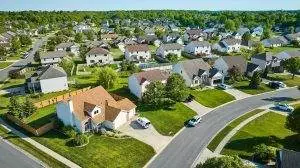When searching for a new place to live, it is crucial to thoroughly explore the surrounding neighborhood as it plays a vital role in shaping the overall quality of life. The neighborhood serves as the backdrop for daily experiences and has the potential to greatly impact the well-being and security of both you and your family.

In this blog, we will carefully examine the important aspects that make a neighborhood desirable. By understanding these key features, you will be equipped to make an informed decision when the time comes to find your dream home. We will delve into topics such as safety measures, the atmosphere, and the sense of community, providing you with the necessary knowledge to navigate the real estate landscape and ensure that your chosen home exceeds your expectations, resulting in a fulfilling and satisfying lifestyle.
12 Best Qualities of a Good Neighborhood
1. Ensuring a Sense of Safety and Security
One of the most important factors to consider when evaluating a potential neighborhood is the need for residents to feel safe within their community. This involves various aspects that contribute to the overall safety and well-being of individuals and families.

A key aspect to examine in the search for a secure environment is the prevalence of low crime rates. Analyzing statistical data on criminal incidents provides valuable insights into the safety profile of the neighborhood. Prospective residents are advised to prioritize areas with low crime rates, as this fosters a safe environment where safety is a top concern.
Another crucial element that contributes to safety is well-lit streets. Illuminated thoroughfares not only enhance the neighborhood’s aesthetics but also deter criminal activities. A well-lit environment promotes a sense of security and facilitates safer movement for pedestrians at night, reinforcing the idea of a secure and well-maintained community.
Community-driven initiatives, such as neighborhood watch programs or a visible police presence, serve as tangible indicators of efforts to cultivate a safe environment. These proactive measures further demonstrate the commitment of residents and local authorities to safeguarding the community, creating a collective sense of responsibility for everyone’s well-being.
Incorporating advanced security systems within residential properties significantly contributes to the overall safety infrastructure of a neighborhood. Features like surveillance cameras, alarm systems, and controlled access points enhance the security fabric of the community, providing residents with an added layer of protection.
The condition of public spaces within a neighborhood is also important to consider. Well-maintained parks, walkways, and communal areas not only enhance the neighborhood’s appearance but also create a sense of pride and community ownership. A neighborhood that values the upkeep of public spaces fosters a secure environment and reflects a collective dedication to maintaining a high quality of life.
The comprehensive evaluation of safety and security features in a neighborhood involves assessing crime rates, street illumination, community initiatives, security systems, and the maintenance of public spaces. These multifaceted considerations collectively contribute to the creation of a secure, inviting, and desirable neighborhood that prioritizes the well-being of its residents.
2. Amenities and Accessibility
When considering an ideal residential environment, the presence and accessibility of amenities are crucial factors that shape the overall convenience and quality of life in a neighborhood. A truly commendable locality goes beyond just providing housing and includes a seamless integration of essential services, educational institutions, healthcare facilities, and recreational spaces.

One important criterion for evaluating the desirability of a neighborhood is the convenient proximity to fundamental amenities. A well-rounded community should ideally offer easy access to grocery stores, allowing residents to efficiently meet their daily needs without having to travel long distances. Similarly, having accessible healthcare facilities is vital for the well-being of individuals and families, ensuring prompt medical attention when required.
For families with children, the availability and proximity of schools are crucial considerations. A neighborhood that offers educational institutions within reach not only makes daily commuting easier for parents and students but also enhances the overall educational experience.
The inclusion of recreational spaces within the neighborhood is equally important. Parks, playgrounds, and communal areas contribute to a well-rounded lifestyle, providing spaces for relaxation, social interaction, and physical activity. Being close to such recreational amenities enhances the overall quality of life, fostering a sense of community and well-being.
In addition to local amenities, the accessibility of a neighborhood is further enriched by evaluating its connection to broader transportation networks. Assessing the distance to public transportation options ensures that residents have convenient alternatives for commuting, reducing reliance on personal vehicles and promoting sustainable urban living. Moreover, proximity to major highways is a vital consideration, facilitating efficient travel within the city and establishing connectivity to different areas, expanding residents’ accessibility, and enhancing their overall connection to the broader urban landscape.
To comprehensively assess amenities and accessibility within a neighborhood, it is essential to scrutinize the proximity and availability of grocery stores, healthcare facilities, schools, and recreational spaces. Simultaneously, evaluating transportation options, such as public transit and major highways, becomes integral in gauging the neighborhood’s connectivity and its impact on the overall convenience and lifestyle offered to its residents.
3. Educational Considerations
Exploring what makes a neighborhood exceptional, the educational aspect emerges as a crucial dimension, especially for individuals with children or those planning to start a family. The quality of nearby schools is of utmost importance, as it greatly influences the educational journey and overall development of the younger residents in the community.

To thoroughly examine the educational opportunities within a neighborhood, it is important to research the reputation and ratings of local schools. This diligent investigation helps determine if the academic institutions in the area meet one’s educational standards and expectations for their child. Analyzing factors such as curriculum offerings, teaching methods, and extracurricular programs provides valuable insights into the overall educational environment and its potential impact on a student’s academic and personal growth.
In addition, the proximity of libraries in the neighborhood adds another layer of educational enrichment. Having access to well-equipped libraries not only supports academic pursuits but also fosters a culture of reading and intellectual curiosity. Moreover, the availability of extracurricular activities like sports clubs or arts programs contributes to a well-rounded educational experience for children. Participating in these activities not only enhances physical and creative skills but also cultivates important life skills such as teamwork, discipline, and time management.
Considering the significance of a comprehensive educational experience, a neighborhood that values and facilitates diverse extracurricular opportunities provides a solid foundation for the development of well-rounded individuals. Therefore, beyond the classroom, offering avenues for intellectual, physical, and artistic pursuits becomes a key factor in shaping the overall educational journey of the younger members of the community.
The educational aspect plays a crucial role in evaluating the excellence of a neighborhood, especially for those focused on raising children. The quality, reputation, and offerings of local schools are important considerations, while the accessibility to libraries and a range of extracurricular activities add enrichment to the educational experience. By prioritizing these educational considerations, prospective residents can ensure that their chosen neighborhood aligns with their aspirations for providing a nurturing and comprehensive educational environment for their children.
4. Green Spaces and Recreational Havens
When evaluating the desirability of a neighborhood, the presence and accessibility of parks, playgrounds, and green spaces are vital. These elements are not just for aesthetic purposes but are essential for creating an outstanding residential community. Green sanctuaries contribute significantly to the overall well-being and vitality of the neighborhood.

Well-maintained parks are an important aspect of a neighborhood’s allure. They offer more than just visual appeal; they serve as vital hubs for residents to engage in recreational activities. These spaces provide opportunities for physical exercise, leisurely walks, and community gatherings, enabling residents to lead healthier lifestyles and build meaningful connections with their neighbors.
Playgrounds are integral components of a family-friendly environment. They signify a neighborhood’s commitment to accommodating the needs of families with young children by providing safe and enjoyable spaces for play and socialization. The presence of playgrounds contributes to a holistic living experience that caters to the diverse needs of residents.
Walking trails add recreational options, promoting an active lifestyle and allowing residents to enjoy the natural surroundings. These pathways not only contribute to physical well-being but also provide serene environments for reflection and relaxation.
Community centers within a neighborhood offer a dynamic dimension to the recreational landscape. They serve as focal points for various events and activities, fostering a sense of community spirit. Residents can actively participate in cultural gatherings, fitness classes, and other events, enhancing the social fabric of the neighborhood and creating opportunities for meaningful interactions.
Considering green spaces and recreational facilities goes beyond visual aesthetics. Well-maintained parks, playgrounds, walking trails, and community centers contribute to the holistic well-being of a neighborhood. By offering spaces for physical activities, social engagement, and community events, these elements play a pivotal role in shaping the vibrancy and sense of community within a residential area. Prospective residents seeking an ideal neighborhood should prioritize these considerations to ensure a living environment that not only appeals to the eyes but also enriches the overall lifestyle and well-being of its inhabitants.
5. Diversity and Community Participation
An exceptional neighborhood is often distinguished by its combination of diversity and active community engagement, which creates an inclusive and vibrant living environment. Beyond physical structures, the character of a good neighborhood can be seen in the diverse tapestry of its residents and their level of involvement in communal affairs.

One important aspect to consider when evaluating a neighborhood’s appeal is its celebration of diversity. A community that embraces multiculturalism shows openness to various perspectives, traditions, and backgrounds. Having a diverse population contributes to creating a dynamic and culturally rich atmosphere, which enhances the overall fabric of the neighborhood.
In addition to diversity, the active involvement of residents in associations or community centers is a hallmark of community engagement. These organized entities serve as catalysts for fostering a sense of belonging and camaraderie among neighbors. By actively participating in resident associations or community centers, individuals can help shape the direction of the neighborhood, address shared concerns, and work together for the betterment of the community.
These organizations often play a pivotal role in hosting diverse events that cater to the interests and preferences of the residents. From cultural festivals and educational workshops to recreational activities, the events organized by resident associations or community centers promote social interaction and strengthen the bonds among neighbors. Through these engagements, residents have opportunities to connect, share experiences, and develop lasting relationships, fostering a sense of community that goes beyond geographical proximity.
Residing in a diverse and engaged community brings benefits that extend beyond the social realm. Active participation in community affairs promotes a shared responsibility for the well-being of the neighborhood, encouraging residents to collectively address challenges, enhance security measures, and contribute to the overall improvement of the living environment.
In essence, the combination of diversity and community engagement is a foundational pillar in assessing an exceptional neighborhood. The celebration of multiculturalism and the active involvement of residents in associations or community centers contribute to creating a dynamic and inclusive living environment. Prospective residents seeking an enriching and fulfilling living experience should prioritize neighborhoods that embody these characteristics, recognizing the profound impact they have on the overall sense of community and the quality of life within the residential enclave.
6. Forward-Looking Perspectives
When considering a potential residential area, it is important to not only evaluate its current conditions but also consider its future development. Striking a balance between the present and future is crucial to ensure that the chosen neighborhood meets both immediate and long-term needs.

One key factor to consider when assessing the future potential of a neighborhood is the presence of signs indicating growth and development. These signs can take various forms, such as ongoing or planned infrastructure projects or the establishment of new businesses. These endeavors not only show how the neighborhood is evolving but also have the potential to enhance the overall quality of life for residents.
Infrastructure projects, such as building new roads or improving public transportation, can greatly improve accessibility and connectivity, as well as provide better amenities for residents. These improvements contribute to a more convenient and desirable living environment that is also poised for future advancements.
Similarly, the emergence of new businesses in the area can indicate economic vitality and increased opportunities for residents. Thriving commercial establishments not only add vibrancy to the neighborhood but also have the potential to increase property values and provide investment opportunities for homeowners.
Recognizing and evaluating signs of growth and development is a strategic consideration for homeowners. Anticipating positive changes in a neighborhood can lead to long-term property value appreciation and the potential for improved community amenities.
While the current state of a neighborhood is important, taking a forward-looking perspective is equally crucial. By assessing signs of growth, ongoing development projects, and the establishment of new businesses, prospective homeowners can gain valuable insights into the future trajectory of a neighborhood. By incorporating this foresight into their decision-making process, they can ensure that their chosen residential area aligns not only with their immediate needs but also with their aspirations for a thriving and sustainable community.
7. Assessing Infrastructure and Public Services
When choosing a neighborhood, it is important to examine the quality of infrastructure and public services available thoroughly. This goes beyond just looking at the physical attributes of the neighborhood itself and includes considering the systems and services that make up a well-functioning residential environment.

One key aspect to assess is the condition of the roads. Well-maintained roads not only enhance the neighborhood’s appearance but also ensure smooth and efficient movement for vehicles and pedestrians. The quality of the roads reflects the community’s commitment to providing a convenient and accessible living environment for its residents.
Reliable utilities are another crucial component of neighborhood infrastructure. Consistent provision of essential services like electricity, water, and telecommunications is necessary for a comfortable and functional lifestyle. Evaluating the reliability and efficiency of these utilities provides valuable insights into the overall resilience of the neighborhood.
An often overlooked but important aspect is waste management. A well-organized waste disposal system contributes to cleanliness and environmental sustainability. This not only improves the neighborhood aesthetically but also has a positive impact on public health and well-being.
In addition to physical infrastructure, the accessibility and proximity to essential public services are also important considerations. Evaluating the accessibility of hospitals, fire stations, and police stations is crucial as these services ensure the safety and security of residents. Quick response times and proximity to emergency services contribute to the overall resilience and preparedness of the neighborhood.
Considering the state of infrastructure and public services is an important part of choosing a neighborhood. Beyond the physical appearance, the condition of roads, reliability of utilities, efficiency of waste management, and accessibility to essential services all contribute to the functionality and well-being of a residential area. By incorporating these factors into their decision-making process, prospective residents can ensure that their chosen neighborhood meets their immediate needs and supports their vision of a thriving community.
8. Local Businesses and Economic Vibrancy
An important factor in determining the desirability of a neighborhood is the strength of its local economy. The state of the economy not only reflects the current vitality of the community but also indicates its potential for long-term growth and success. When evaluating a residential area, it is crucial to carefully consider the local businesses and economic dynamics to make an informed decision.

One key aspect to examine is the diversity and abundance of businesses within the neighborhood. A wide range of businesses, including restaurants, shops, and services, demonstrates the economic richness and commercial dynamism of the community. These diverse businesses not only cater to the various needs of residents but also contribute to a vibrant and diverse local atmosphere.
Restaurants and shops, in particular, are representative of the social and cultural fabric of a neighborhood. A thriving culinary scene and a variety of shopping options not only enhance the overall lifestyle for residents but also attract visitors, fostering a sense of community engagement and shared experiences.
Furthermore, the presence of local businesses provides employment opportunities, promoting economic inclusivity within the neighborhood. A strong local economy can lead to job creation and career prospects for residents, ultimately improving the socioeconomic well-being of the community.
Aside from the existing businesses, the proximity of commercial centers is also an important consideration. Access to established commercial hubs offers convenience and a wide range of choices, further enhancing the living experience for residents. Additionally, it is crucial to consider the potential for future economic growth, such as planned developments or investments, as this can provide valuable insights into the neighborhood’s trajectory and potential for sustained economic prosperity.
Evaluating the local businesses and economic vitality of a neighborhood is crucial in determining its overall appeal. The diversity of businesses, the vibrancy of the culinary and retail scene, and the economic opportunities they bring contribute to the character and vitality of the neighborhood. Prospective residents seeking an exceptional living experience should prioritize neighborhoods with a thriving local economy, recognizing the significant impact it has on both the present and future prosperity of the community.
9. Acoustic Considerations and Environmental Dynamics
When carefully selecting a residential setting, it is crucial to evaluate the noise levels and environmental factors that contribute to a peaceful living environment. This evaluation goes beyond the physical structures and takes into account the auditory and environmental dimensions that greatly impact residents’ overall well-being.

One important aspect to consider is the proximity to busy roads, airports, or industrial areas, as they can significantly affect the acoustical ambiance of a neighborhood. Assessing the surrounding auditory landscape allows residents to make informed decisions based on their preference for a quiet living environment.
In addition, the presence of green spaces, parks, and environmental conservation efforts should be taken into consideration. Not only do they enhance the neighborhood’s visual appeal, but they also help mitigate noise pollution. Nature acts as a natural sound buffer, creating an environment that promotes tranquility and serenity.
Air quality and other environmental factors should also be given attention. Clean air, free from pollutants, is essential for residents’ overall health and well-being. Evaluating the neighborhood’s commitment to environmental sustainability and identifying any potential factors that may impact air quality are crucial steps in ensuring a wholesome and conducive living space.
In summary, considering noise levels and environmental factors is a comprehensive approach to creating an ideal residential haven. Those seeking a peaceful living environment should carefully assess the proximity to sources of noise pollution, while also embracing neighborhoods that prioritize green initiatives and environmental sustainability. By incorporating these considerations into the decision-making process, individuals can ensure that their chosen residential enclave aligns harmoniously with their preferences for auditory tranquility and a healthy environment.
10. Cultivating Community Bonds
When looking for an ideal residential enclave, it is important to consider the cultivation of a strong sense of community. This goes beyond the physical attributes of the neighborhood and plays a significant role in enhancing the overall quality of life for residents. Prospective inhabitants are advised to explore various aspects that contribute to fostering a robust sense of community.

One key aspect to consider is the presence of local events, festivals, and social gatherings that promote community engagement. These activities not only showcase the vibrancy of the neighborhood but also provide opportunities for residents to connect, share experiences, and build meaningful relationships with their neighbors. These shared moments help shape the character of the community and create a tapestry of collective memories.
Another important factor is the presence of dynamic homeowner associations or community groups. These organized entities often play a crucial role in coordinating activities that foster a sense of belonging among residents. They organize community-wide events and address shared concerns, creating a cohesive and supportive living environment.
The friendliness and welcoming attitudes of residents are also essential in building a strong sense of community. A neighborhood where newcomers are embraced and residents actively contribute to a hospitable atmosphere enhances the overall sense of community. This welcoming ethos lays the foundation for lasting relationships and creates a support network and camaraderie.
In conclusion, the cultivation of a strong sense of community goes beyond physical boundaries. It involves shared experiences, organized events, and a culture of friendliness among residents. Prospective inhabitants should look for neighborhoods that prioritize community engagement, exemplified by vibrant local events, active homeowner associations, and a welcoming atmosphere. By focusing on these community-building aspects, residents can ensure that their chosen residential enclave meets their immediate needs and aligns with their aspirations for a connected and supportive community life.
11. Long-Term Investment Potential in a Neighborhood
When choosing a residential neighborhood, it is important to consider more than just the immediate living experience. Assessing the long-term investment potential is a prudent step to ensure that the chosen neighborhood not only meets immediate needs but also aligns with the prospective homeowner’s aspirations for sustained financial growth.

A crucial part of this evaluation process is researching property values and trends in the area. By examining historical data and current market conditions, prospective buyers can get a sense of how property values have performed in the past and make predictions about potential future trends.
Additionally, it is important to consider planned developments in the neighborhood. Infrastructure improvements, urban revitalization initiatives, and commercial expansions can have a significant positive impact on property values. Identifying and understanding these planned developments can provide a strategic advantage in predicting real estate appreciation over time.
Transportation improvements also play a vital role in assessing long-term investment potential. New or improved transportation infrastructure, such as highways, public transit systems, or connectivity to major urban centers, can enhance accessibility and positively influence property values. The convenience offered by efficient transportation options tends to attract buyers and contribute to the desirability of the neighborhood.
Evaluating the overall economic growth of the neighborhood is indispensable. A thriving economy, job creation, and increased commercial activities can stimulate demand for housing and drive property values upward. A neighborhood with a strong economy not only improves residents’ quality of life but also positions itself favorably for sustained real estate appreciation.
By thoroughly analyzing property values, trends, planned developments, transportation improvements, and economic growth, prospective homeowners can make informed decisions that align with their aspirations for enduring financial prosperity in real estate. This strategic approach ensures that the chosen residential enclave not only provides a comfortable living environment but also serves as a sound and lucrative investment for the future.
12. Personalized Exploration of Neighborhood Preferences
Selecting a residential enclave involves conscientiously considering personal preferences and unique requirements to find the ideal neighborhood. Beyond objective criteria, it is important to evaluate individual and familial needs to ensure that the chosen community aligns harmoniously with distinctive lifestyle choices and priorities.

Proximity to family and friends is a fundamental consideration. Being close to loved ones significantly influences the quality of life for many individuals and families. Assessing the accessibility of the neighborhood to the locations of family members and close friends helps create a supportive and connected living environment.
Cultural and religious institutions also play a significant role in shaping one’s sense of belonging and fulfillment. Many individuals seek neighborhoods that provide access to community centers, places of worship, or cultural hubs that resonate with their values and traditions. These considerations contribute to a sense of cultural continuity and community integration.
Specific hobbies and interests are crucial in defining the ideal neighborhood. Whether it’s parks for outdoor enthusiasts, art galleries for creative individuals, or sports facilities for fitness enthusiasts, aligning the neighborhood with one’s interests enhances the overall living experience.
Considering daily routines and how the neighborhood accommodates them is another important aspect. Factors such as commute times to work, the availability of essential services, and the compatibility of the neighborhood with daily activities contribute to the overall convenience and functionality of the living environment.
Acknowledging any other aspects that hold personal importance is very important. This could include preferences for a quiet and peaceful environment, a vibrant and lively atmosphere, or a balance between urban and suburban characteristics. Personalizing the search for a good neighborhood involves identifying those intangible qualities that contribute to a sense of fulfillment and contentment in daily life.
The quest for an ideal neighborhood is a highly personal journey that goes beyond standardized criteria. By considering factors such as proximity to loved ones, access to cultural or religious institutions, alignment with specific hobbies, and accommodation of daily routines, individuals can tailor their living environment to reflect their aspirations and contribute to a truly satisfying and fulfilling lifestyle.







